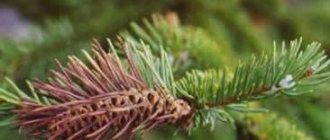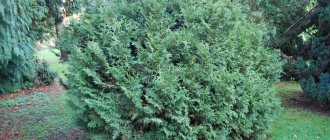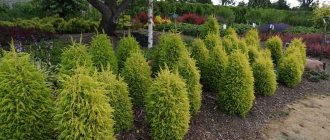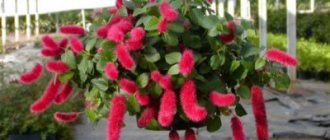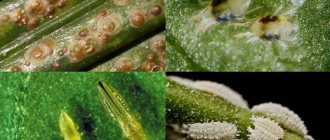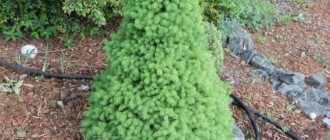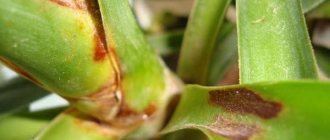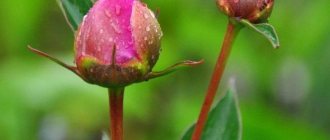Late blight
Late blight is considered the most famous and dangerous fungal disease of thuja. This is a root disease that destroys its top layer. This is reflected in the appearance of the thuja as follows: it withers, turns gray, and the lower part of the trunk becomes soft to the touch. The tissue under the bark will turn brown and a coating will appear underneath. The root becomes brittle and smells rotten.
Phytovtora thuja - a dangerous fungal disease
Basically, late blight affects thujas growing on soil that is poorly drained; the water here often stagnates.
Treatment
To prevent late blight, it is necessary to frequently water the thuja with fungicides. If the disease nevertheless reaches it and the roots fester, it is best to destroy the tree and replace the soil, since this fungus can live for a long time.
Precautionary measures
The hazard class of the drug Fundazol for humans is 2 (highly toxic substance), for bees - 3-4 (moderately toxic substance).
As mentioned above, precautions must be taken when working with the drug.
Photo rules for precautions when using the drug
Such events include:
- use of protective equipment for hands, eyes, respiratory tract: gloves, goggles, respirator;
- when the work is completed, you must wash your hands thoroughly with soap (if possible, take a shower) and rinse your mouth well;
- During treatment with the product, it is strictly forbidden to eat, drink, or smoke;
- If possible, it is worth spraying the surrounding area in which the product was treated with plain water.
Attention!
You should not use Fundazol for residential premises. Such products as Trichodermin, Bioreid, Gaupsin, Fitosporin are more suitable.
Pros and cons of the drug Fundazol - video
Brown shoots
This is a fungal disease that appears in early spring. You can notice it by its yellowed scales. At a late stage of development, the disease affects the entire shoot and it dies.
Brown shoots
How to overcome it?
To protect the thuja from this disease, it is constantly fed, and the roots are also sprinkled with limestone. During the period July-October until October itself, it is advisable to spray the thuja with Fundazol (2% solution) every 2 weeks. If you see at least one affected shoot, it should be cut out immediately, and then the disease will not spread further.
How does Fundazol work?
The place of penetration into the plant is the leaf plates and root system.
More precisely, the product penetrates through one of these pathways. One part of the drug is converted to carbendazim. It is this that has the properties of a fungicide and prevents the action of the fungus. Its effect is superficial. Even if there are only initial symptoms, the activity of the fungus, which is in the initial stage of its development, is already suppressed.
How to use Fundazol - video
Fundazol perfectly solves problems with plants such as:
- anthracnose;
- powdery mildew;
- gray rot;
- Phomasis;
- wilt (fusarium and verticillium wilt);
- late blight
- and others.
True, not all diseases can be eliminated by a remedy. For example, downy mildew and rust are not affected by it.
Thuja false scale
If the bark is covered with yellow ulcers that gradually grow and increase in size, your tree has contracted the false scale insect. Treatment should be started immediately, otherwise this disease will cause spots to cover the entire trunk and it will die.
Thuja false scale
How to treat?
In order to destroy the false scale insect, the following means are used: Rogor, Karbofos, Actellik, Antio.
There are also traditional methods. To prevent this disease, you can wrap the trunk with straw or burlap. At the same time, treat the branches with a soap solution containing denatured alcohol (15 grams of soap, 10 ml of alcohol and 1 liter of warm water). Another way is to apply special caterpillar glue to the surface (this will prevent pests from reaching it).
Once you notice just a few larvae, try simply brushing them off with a brush or knife without damaging the bark.
The most common pests of thuja
In addition to diseases, some pests also pose a danger to thujas. All of them can be divided into three groups:
- sucking pests;
- mining pests;
- xylophages, or stem pests.
Although the nature of the damage to these insects differs, most of them are affected by the same substances. However, there are still some features in the fight against them, and therefore they should be taken into account when selecting treatment.
Weevils
Excessively acidic soils can lead to the appearance of stem pests on the thuja - weevils, which are equally dangerous in both the larval and mature stages. Adults of these insects eat the bark of young shoots, while the larvae damage the roots of the plant. The activity of such pests provokes browning of the ends of thuja branches and shedding of scales. The treatment in this situation is spraying the thuja with insecticides and, if necessary, liming the soil under the thuja.
Thuja fox moth
The digitalis moth is considered a leaf-mining insect. Externally, an adult specimen of this pest looks like a small butterfly with a wingspan of up to 2 cm. It has a smooth or slightly scaly head with antennae and large round eyes. The narrow body and dark wings are decorated with patterns of white spots and stripes.
Like all butterflies, adult insects do not pose a direct threat to plant health. The caterpillars of these pests, on the other hand, eat tunnels into the needles of the thuja, which is why it turns yellow and the growth of the bush slows down. The activity of such larvae is easy to detect by the holes on the scaly leaves. It is difficult to completely get rid of these pests, but it is possible if you treat infected thujas twice with Karbofos, Kinmiks or Decis.
Thuja leaf miner
Another leaf-mining pest of the thuja bears the self-explanatory name of the thuja leaf-mining moth. Adult insects reach a length of 5 mm and have a silvery-brown color with brown stripes, which allows them to successfully camouflage against the background of the bark. These pests are most active during May-June, when moth caterpillars begin to feed heavily before pupating. They damage the internal structure of the needles, which ultimately leads to deformation of the shoots and the appearance of yellowness in the crown.
Various insecticides will help destroy mining pests. The first treatment of thuja should be carried out in the spring, before the moth caterpillars move to new shoots, and the second - at the end of summer.
| Advice! For greater efficiency in pest control, you can use special traps with pheromones. |
Thuja aphid
Thuja pests such as thuja aphids, which can be seen in the photo, can significantly spoil the appearance of thuja. These small grayish insects draw sap from shoots at the age of 2 - 3 years, which, together with their enviable fertility and colonial lifestyle, makes them very dangerous for weakened plants.
| Important! The thuja aphid is capable of producing offspring 4-5 times in one summer season. |
Deprived of nutrients, the needles turn brown during the summer and die in the fall until the trunk is exposed.
It is possible to cope with thuja pests if you treat the plant with insecticides, for example, Fufanon from May to June, with repeated treatment of thuja in the summer in the later stages of infection. In addition, it is advisable to wash the infected areas with a soapy mixture, covering the ground so that the soap does not reach the roots of the thuja. Such procedures should be done regularly once every 7-10 days for a month. In this case, it is necessary to ensure that the solution does not come into contact with the roots of the thuja.
Thuja false scale
The thuja false scale insect is a miniature insect up to 3.5 mm in length. It has a slightly convex spherical body of yellow-brown color. Like the thuja aphid, the false scale insect is a sucking pest. A plant affected by this insect becomes covered with yellow ulcers, which quickly spread over the entire surface of the bark. A long absence of treatment can result in the death of the thuja, and therefore it is necessary to treat the plant with medications at the first alarm signals. As a rule, Actellik, Karbofos, Antio are used for this, and connoisseurs of folk remedies use a soap-alcohol solution mixed at the rate of 15 g of soap and 10 ml of denatured alcohol per 1 liter of water.
Juniper scale insect
The juniper scale insect looks like the false scale insect in size and body color, but has one significant difference - its shell is attached to the body so tightly that it cannot be separated. It is believed that scale insects cause much less harm in comparison with the above-mentioned insects, but in large numbers they cause problems, up to the complete drying out of the thuja. This pest can be eliminated using the same methods as the false scale insect.
Thuja and juniper pine beetle
Thuja and juniper pine beetles cause a lot of trouble for gardeners. They are classified as stem pests that gnaw tunnels in the thuja bark and feed on the wood. Most often, they settle on plants that are not cared for carefully enough, however, pests can enter the area with recently purchased seedlings, so when purchasing thujas, you should carefully inspect them. The best treatment against pine beetle infestation is treatment with insecticidal compounds. And if you additionally treat thuja with Bordeaux mixture, its resistance to pests will increase significantly.
Spider mite
Spider mites often prefer thujas, which grow where there is insufficiently moist soil and dry air. This pest multiplies surprisingly quickly, entangling thujas with cobwebs during its life. Treating the bush with acaricides, as well as infusions of garlic or dandelions will help repel harmful arachnids.
| Advice! Regular sprinkling of thuja will help prevent the appearance of spider mites. |
Schutte and rust
Fungal diseases manifested by darkening and falling of needles. They begin in the spring and spread throughout the year. Mostly young trees are affected.
Schutte and rust are the most dangerous diseases of thuja
How to remove rust and shutte? The best drugs for prevention
To stop the development of the disease, it is necessary to cut off all affected branches and burn them to prevent it from spreading to other coniferous trees. But this doesn't always help.
It is best to treat affected trees with HOM. The consumption rate of the drug is 40 g/10 l of water. This solution should be sprayed on the affected trees twice a season: in the spring (May) and in the summer when the disease reappears. Since both schutte and rust are common to all conifers, it is worth carrying out preventive treatment of the rest of the conifers (all, without exception). It is carried out with the same HOM in the same dose, but only once in the spring.
If there is no effect, you need to shed the trunk circles of the affected trees with Fundazol. The consumption rate of the drug is 20 g/10 l of water - a solution (0.2%) is obtained, which is poured onto the trunk circle of the affected tree once per growing season. There is no need to spray the trees with it, only the soil to destroy the infection in it.
Topsin-M is also used for Schutte: the consumption rate of the drug is 15 g/10 l of water, this solution is consumed for 1 adult plant. Spraying is carried out once in the spring after the threat of night frosts has passed.
Instead of HOM, you can buy Bordeaux mixture. This is an old, but very effective and proven remedy, suitable for many cultures. You don't have to buy it.
Homemade Bordeaux mixture recipe
It's easy to prepare it yourself. The purchased bag contains lime and copper sulfate. This means that to prepare ten liters of a one percent solution you will need 100 g of lime and 100 g of vitriol.
It is prepared like this:
- Vitriol (copper sulfate) is diluted in a glass or wooden container (in no case iron or plastic!). Add up to five liters of water, do the same with lime in another container;
- The diluted vitriol is carefully poured into the slaked lime;
- Stirs. You should get a light blue liquid;
- To understand whether we have poured in a sufficient amount of copper sulfate, we need to take an iron object that is not covered with rust (for example, a knife) and lower it to the bottom of our liquid. The appearance of a red coating means too much;
- This can be easily fixed by adding lime. It is necessary to check, otherwise you can burn the plants.
With this working solution, preventive spraying can be carried out every spring (during the growth of new needles) at the rate of 10 l/100 m².
The most common thuja diseases and their treatment
Insects
In addition to diseases, thujas can be attacked by insect pests, including aphids, spider mites, and thuja weevils.
In addition to chemicals (Fufanon), you can use folk remedies for spider mites and aphids.
Spray treatment with garlic infusion.
Soak for 24 hours 100 g of fresh garlic in 5 parts. l. vegetable oil. Strain it all and add it to a liter of water with 1 tbsp. l. laundry soap. Spray the mixture once a week on the attacked thujas.
Mixture with laundry soap
You can choose a mixture of a teaspoon of laundry soap, a teaspoon of vegetable oil and a teaspoon of 70° alcohol. Pour all this into a liter of water and spray on the thuja.
Main diseases of ornamental conifers
The tips of the needles begin to turn yellow for various reasons. In the spring, the bright sun causes burns and a bronze appearance appears. Common infections include fungal infections. Rust appears more often on pine, and juniper is affected. From swellings that appear on the branches, spores are transferred to currants and pears. Fusarium, cytosporosis, and phomosis are considered dangerous diseases. Thuja suffers from them. Defects appear on the bark and branches. The needles darken and fall off.
Old, unkempt trees are susceptible to diseases. There are breeds of conifers that are resistant to fungal diseases. But they are not immune from caterpillar attacks. There is only one conclusion: if you plant evergreen forest wonders on your site, study ways to combat infections and pests.
Autumn care for thuja and preparation for winter
In August, you no longer need to fertilize the thuja. This will stop the growth of young shoots and protect the tree from the cold. Be sure to water the soil before insulating the bush, as it will continue to consume moisture.
Features of preparing thuja for winter:
- Cover the soil around the trunk with dry leaves or tree bark. The thickness of the layer is 10 cm.
- For young trees up to 3 years old, press the branches to the trunk and tie them with a rope. Wrap in non-woven material, for example, a white bag.
- For mature trees, tie the branches with rope to prevent them from breaking under the weight of the snow. In winter, shake the snow cover periodically.
Causes
Thuja, like other plants, does not get sick for no reason. Diseases are caused by a variety of factors, the main ones of which include the following:
- a physiological cause is characteristic, for example, of fungal diseases;
- infections also occur among plants;
- one of the reasons that the thuja dries out is improper care of the tree, for example, too high a concentration of fertilizers;
- lack of watering and soil freezing in the cold season;
- lack of nutrients;
- constant moistening of undrained soil;
- contact of waste from domestic animals on the surface of the tree;
- attacks of seasonal pests.
The presence of these reasons explains the need for comprehensive protection of thuja from the effects of various negative factors.
And despite the fact that caring for this tree is not difficult, it is complex and requires taking into account various details.
Application at the root
Both liquid and dry nutrient compositions are applied under the root. One of the best types of organic matter for our species of conifers is compost. In dry form, they cover the tree trunk circle with a layer 3-5 cm thick, and then carefully mix it with the top ball of soil, without damaging the roots of the thuja. Bone meal and humus are used in the same way.
For coniferous species there is a range of granular fertilizers with prolonged action. When introduced at the beginning of the season, they contribute to the rapid growth and growth of lush green mass of shrubs throughout the entire growing season. The drug Fertika “Coniferous for evergreens - Spring”, which contains water-soluble calcium, has proven itself well.
When distributing granules around plants, do not go beyond the crown projection and do not approach the trunk closer than 15 cm. For large specimens, the amount is calculated based on the crown projection area.
Water-soluble preparations, such as ammonium nitrate, superphosphates, and liquid compositions based on vermicompost, are diluted with water before use according to the instructions on the package.
Fertilizer application during planting
So, the first, most important addition of nutrients occurs during planting of young thujas. Adequate nutrition at the start is ensured by adding ash and organic matter - compost or rotted humus - to the planting pit.
For a hole with a diameter and depth of 1 m you will need about two buckets of organic matter and 3 kg of wood ash. The ash is evenly distributed along the bottom, the compost is mixed with soil for backfilling.
If the planting pit has been prepared properly, the necessary fertilizer complex has been applied, no additional fertilizing is carried out this year. Do not forget that an excess of minerals is no less harmful to thuja than their deficiency.
Reader Questions
What is the price of Fundazol?
The average cost of the drug is 25 rubles per 10 grams.
Which manufacturers produce Fundazol?
The following manufacturers produce the product:
- KFT" Hungary (Moscow representative office of "Agro-Kemi");
- CJSC "August"
A remedy for fungal diseases in the garden!
Bordeaux mixture
Fundazol Extra: what are its advantages?
Fundazol Extra has several advantages over drugs that have a similar effect:
Efficiency:
the product has a truly unique structure and the action time is faster than similar products and the consumption rate is less.
Quality:
Fundazol Extra contains only materials of proven and high quality, the control of which is carried out in a laboratory.
Complex action and wide spectrum of action.
How long after treatment with Fundazol can the crop be harvested?
The last treatment with Fundazol should be carried out no later than a week before harvest.
Fungicide Fundazol is an effective drug that will quickly help cope with fungal diseases of plants, garden crops, and eliminate insects and pests.
The product is effective and powerful, and therefore it is worth remembering safety precautions when working with it and, of course, strictly following the indicated dosages. Since the drug is quite difficult to find, there are analogues and substitutes for the drug.
Fertilizing in spring
The first application of fertilizers after planting is made the following spring. Further, spring feeding becomes a permanent element in caring for thujas. It is held from the beginning to the end of March, depending on the climatic region.
During this period, the main minerals that thuja needs are:
- Nitrogen.
- Phosphorus.
- Potassium.
- Calcium.
- Iron.
- Magnesium and others.
Fertilizing thuja in the spring includes superphosphates, ammonium nitrate, mixtures containing potassium and magnesium, calcium preparations, and complex long-acting fertilizers. One of the best sources of calcium and beneficial organic matter is bone meal.
If young thujas did not survive the winter well, suffered from frost, or received wind or sunburn, root formation stimulants are used to help the plants grow stronger. This could be Kornevin or Agrekol.
Treatment
Fusarium is difficult to treat. If the disease occurred, then the reason for this could be the use of low-quality plants, improper planting, or insufficient care. It is necessary to first determine what is the cause of the development of the disease. If wilting is caused by stagnant waterlogging, then it must be eliminated before treatment. If the cause is poor-quality or diseased planting material, then it is more advisable to replace it with preliminary thorough treatment of the soil with fungicides. It is better to avoid using fusarium-prone plants altogether and plant resistant crops or wait several years before planting removed crops.
If the plants are planted too densely and there is no normal lighting and ventilation, then pruning and cutting of interfering specimens is carried out. In this case, it is necessary to take precautions: treat instruments with antiseptic drugs when moving from one instance to another. A solution of alcohol, medical antiseptics (Chlorhexidine, Miramistin), and concentrated solutions of fungicides are suitable for this.
If the development of wilting was facilitated by excessive zeal in feeding plants, then the actions taken should be reconsidered and the application of fresh manure and unrotted plant residues should be abandoned forever.
The treatment of diseased plants itself includes external treatment of crowns with systemic fungicides, the introduction of adapted fungicidal preparations under the bark of tree crops (stem injections), dressing and soil disinfection. All these activities should be carried out several times with an interval of 2-4 weeks. After eliminating the symptoms of the disease, treatment should not be stopped, but continued until a stable result is achieved.
The treatment method is selected individually based on the current situation. For thickened old monoplantings with the loss of half of the plant specimens, for example, the best solution would be to completely remove the remaining plants and replace them with resistant species. And for young gardens with plants incorrectly arranged by landscape designers, with the drying out of single specimens, it is necessary to carry out comprehensive measures to improve the garden (spraying, replanting, fertilizing, etc.), which will eliminate possible risks in the distant future and significantly reduce future costs of garden maintenance.
Self-treatment of fusarium in the garden
On the Internet you can find a large amount of conflicting information about the use of certain chemicals to treat fusarium. We deliberately do not provide treatment regimens, since in our practice we have repeatedly encountered the incorrect use of chemicals.
Let us recall that for the treatment of fusarium, it is recommended to treat plants with systemic fungicides, and these are the most powerful (and dangerous) pesticides produced by the modern chemical industry.
On the Internet, many texts are simply copied or rewritten. For an ignorant person who writes an article (and believe me, these are the people who most often fill sites with information by simply rewriting other people’s articles), it is impossible to correctly navigate the unfamiliar names of pesticides. These names migrate invariably from article to article. And the gardener, who easily found a life-saving treatment plan on the Internet (and even more so found it on other pages of other sites and was confirmed in his correct choice), did not realize that the described scheme was originally rewritten from a textbook fifty years ago, and then was transformed beyond recognition copywriters and rewriters, and, most importantly, she worked fifty years ago, but not now! As a result, a gardener or a newly minted gardener, who grew up in a hot plain and has never seen coniferous trees before, buys foundation ash in the store and waters the garden with it generously. Having not achieved the desired result, he goes to the store for Quick or Topaz and repeats the treatment. Then Fundazol again. And so on according to the scheme and at your own discretion...
Amateurism in this case can lead to:
- to chemical burns of plants,
- to growth deformities,
- resistance (resistance) of the pathogen to commonly used drugs (most common),
- poisoning of people and animals,
- poisoning the soil for many years.
Therefore, we do not describe “one hundred percent” treatment plans on this site, but provide face-to-face consultations and help online via email correspondence. Write or call, do not look for a simple solution on the Internet and beware of scammers. Yes, yes, there are scammers among gardeners and plant pathologists! If you plan to hire a specialist, ask about their qualifications and education before you start working with them.
In the winter months, conifers have an especially hard time when frosts alternate with sharp thaws - this is exactly what happened last winter. After such a winter, plants must be helped to protect themselves from diseases and pests.
Last winter was damp and warm - this helped the pests, which with the arrival of spring begin to attack coniferous crops, to successfully overwinter. High humidity coupled with slightly above-zero temperatures created a favorable environment for the proliferation of spores of fungal infections. Conifers cannot cope with such troubles alone - a gardener with a sprayer is needed.
